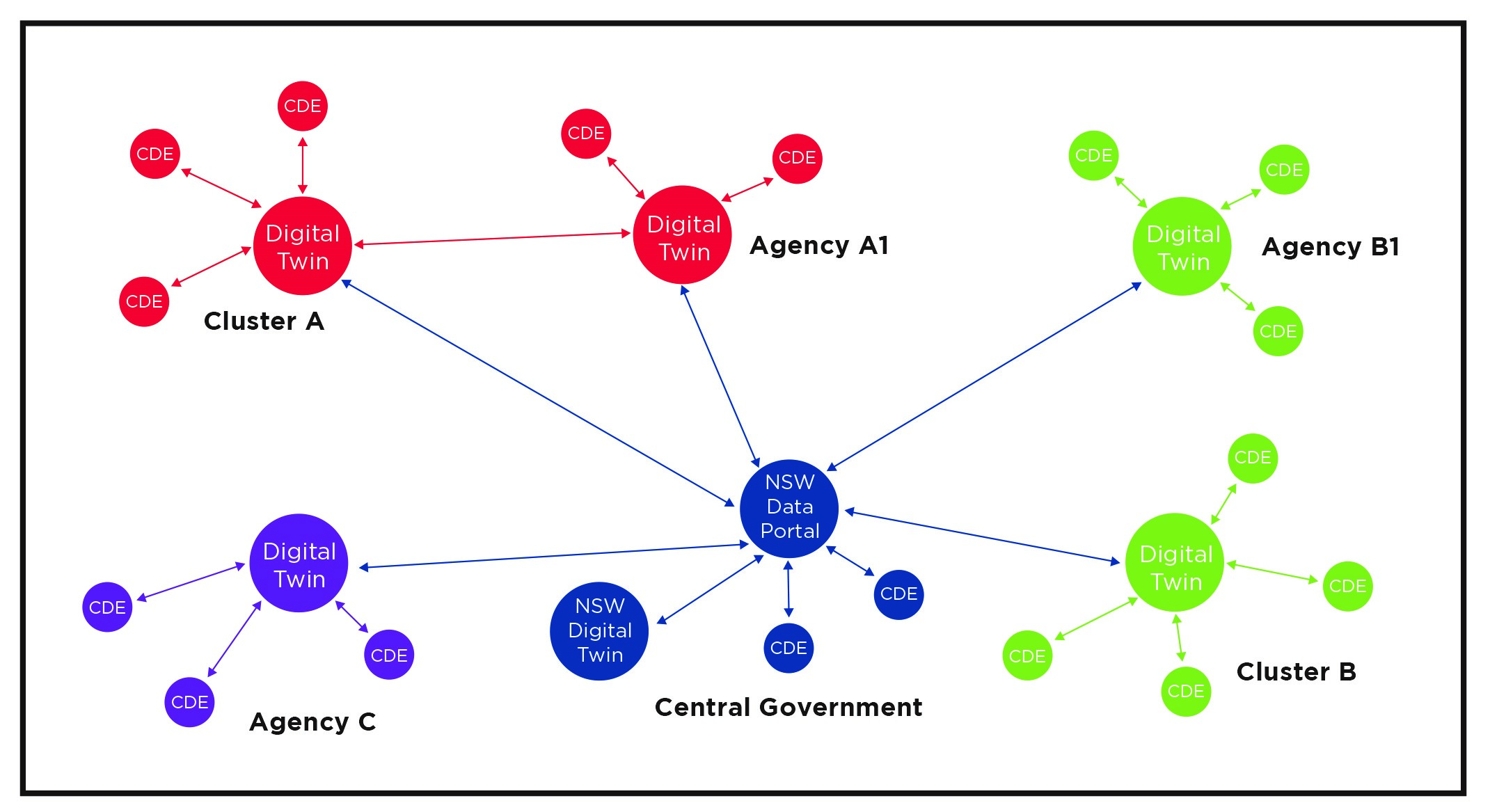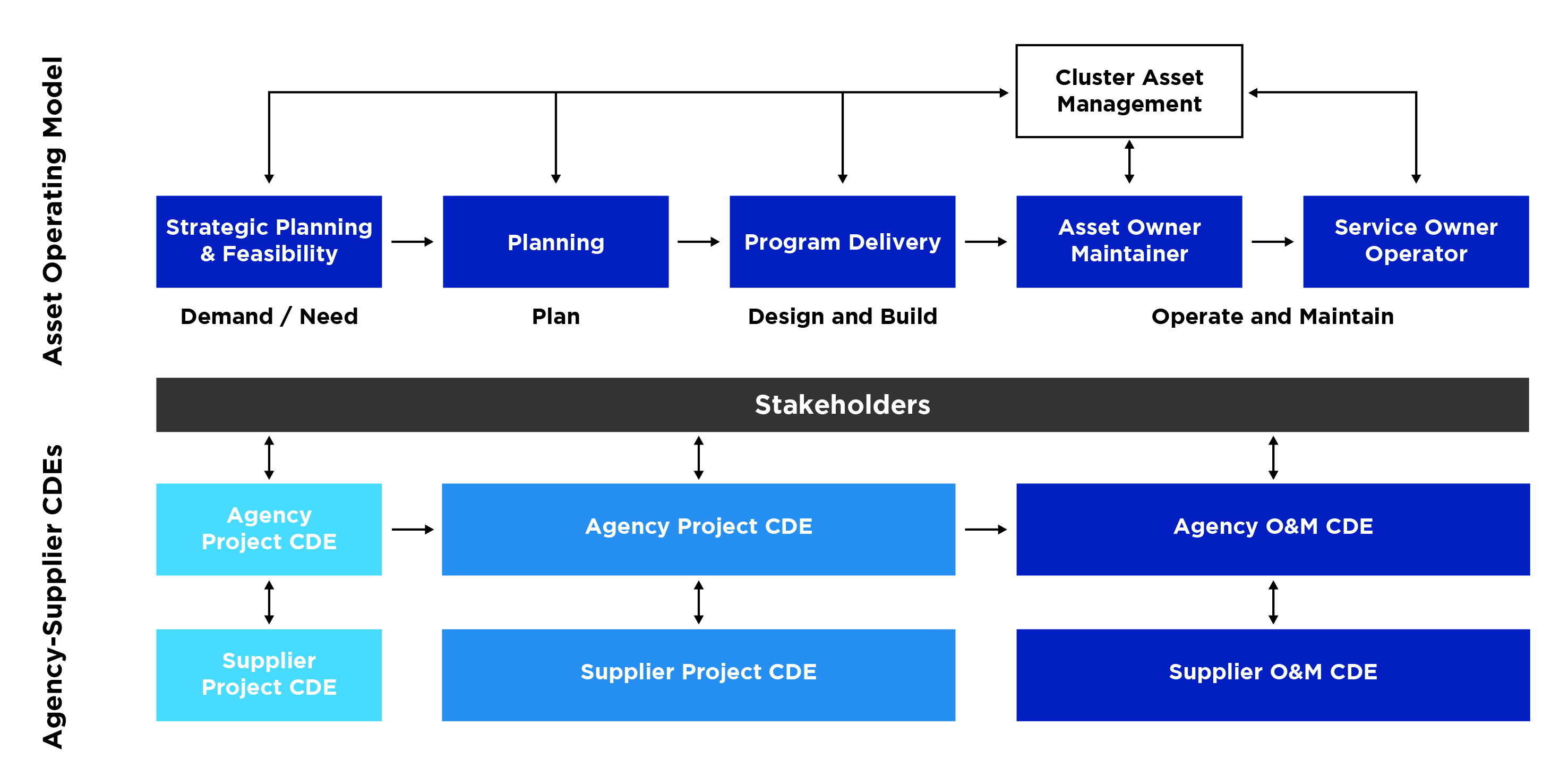With the increasing speed, volume and complexity of data in modern society, humans are becoming more reliant than ever on technology to manage and monitor data. The capture, management and use of infrastructure data is supported by a range of technologies, such as design, project management and building information modelling software, which are widely used within the construction sector. However, interoperability and collaboration are important considerations in the use of these technologies.
A key consideration in adopting various technologies includes the decision on the most appropriate technology architecture. The vision to establish digital twins to enable smart places and infrastructure will require the establishment of digital twins at different levels within NSW Government. This increases the importance of an ecosystem of connected technology environments (platforms) to enable all the stakeholders to connect their systems at the data layer, as illustrated in Figure 9.

NSW Government is on the way to successfully connecting the different environments of agencies through Data.NSW and the NSW Digital Twin, however it requires technology platforms to become more “open” for all stakeholders to participate in a connected data ecosystem.
From an infrastructure data perspective, the ability of software platforms to support the relevant open data standards will become more important over time. If this state of inter-connected ecosystem is not achieved NSW Government and agencies will continue to need to support complex data transformations between different technology platforms.
What good looks like
- Interoperable: Systems are set up to facilitate operating effectively in inter-connected data environments (for more detail, see Section 4.2.1 on Common Data Environments)
- Secure data access for multiple project parties
- Faster, consistent setup for new projects
- Offsite access to drawings and project information
- Faster, more informed approval
- Less admin and more efficient data processing
- Enterprise technologies for the data analysis of business information
- Graphical user interfaces to provide summarised report views of data
- Processing of large volumes of data
- Capture of large volumes of spatially enabled real time data
- Permission based access to sensitive data.
How to achieve good practice
- Invest in data storage and exchange in common environments
- Ensure IT platforms are pre-configured to enable infrastructure data management
- Infrastructure data is accessible on mobile platforms
- Procure or develop software for reviewing 3D/BIM models
- Develop bulk production drawings from 3D/BIM models
- Invest in Business Intelligence and Data Analytics
- Utilise dashboards to provide accessible and interactive views of data
- Develop Artificial Intelligence / Machine Learning capabilities to improve data processing efficiencies
- Invest in Internet of Things (IoT) to enable capture of spatial data
- Utilise data sharing platforms that enable permission-based access to sensitive data
- Require consistent application of modern Coordinate Reference System(s) and spatial data transformation(s).
At an Agency level it is important to define how to establish interconnected environments for different phases of the asset lifecycle, including how best to share and connect information between the agency and industry partners. This ability to share and connect is created through the establishment of Common Data Environments. To ensure consistency the use of Industry Reference data environment models and domain-specific models should be adopted where possible.
Common Data Environments
A Common Data Environment (CDE) is defined in AS ISO 19650.1:2019 Organization and digitization of information about buildings and civil engineering works, including building information modelling (BIM) - Information management using building information modelling, Part 1: Concepts and principles as the agreed source of information for any given project or asset, for collecting, managing and disseminating data and information through a managed process.
A CDE is essentially a collective name given to a group of integrated IT systems within an organisation that enables users to store, collaborate and exchange information and data. A CDE could be a project server, extranet or file-based retrieval system. Increasingly CDEs use cloud-based software to hold and share the relevant infrastructure information.
Agencies typically will have a CDE for the receipt, validation and approval of information delivered by suppliers, while suppliers will have a supply-side CDE used by their teams, including sub-contractors, which is illustrated in Figure 10. The relationships between the CDEs are shown in parallel with the Asset Operating Model in the top half of the figure to represent the changing CDEs over the lifecycle of the asset.

Even though the term CDE is primarily used in the context of projects, the concept applies to all phases of the asset lifecycle, where an enterprise asset management system would be the primary component of a CDE during the Operations and Maintenance (O&M) phase.
Benefits of using a CDE
The CDE as the single source of information means there is no uncertainty about which version of information should be used or referenced. The CDE should serve as the ultimate source of 'truth' and bring a number of benefits for all stakeholders:
- Shared information should result in coordinated data which will, in turn, improve efficient and effective activities and decisions
- Reduce the time and effort required to check, version and reissue information
- Reuse of information to support construction planning, estimating, cost planning, facilities management, and other O&M activities
- Reduce the time and cost of producing coordinated information
- Improve spatial co-ordination through use of a centralised 3D model (BIM and/or GIS)
- Production of models, documents and data should be right first time assuming that contributors follow agreed processes for information development and sharing
- Improve spatial co-ordination through use of agreed Coordinate Reference System(s) and spatial data transformation(s).
CDE requirements
The successful management of information in a CDE requires agreement from key stakeholders on:
- information formats
- delivery formats
- structure of information models
- the means of structuring and classifying information
- attribute names for metadata, for example documentation numbering schemas, and asset and location classifications.
The development of smart places and smart infrastructure (including the use of smart sensors) will significantly increase the volume of data that will be managed and shared. The large volumes of data involved will require the use of dedicated data management and analytics technologies.
One of the key challenges for infrastructure data management is making use of the vast amounts of data now being collected. Advanced Analytics, Artificial Intelligence, and other forms of machine learning can help to extract maximum information (value) from the huge volumes of data about infrastructure assets. Machine learning tools can enhance data integrity by eliminating human error, free up resource hours and significantly cut costs. More information on suitable technologies are provided in the Internet of Things Policy and Smart Infrastructure Policy.
It is recommended that agencies include these requirements as part of maintaining their infrastructure technology environment. There is a global shift to cloud-based solutions to support data storage and exchange, which needs to be managed in accordance with relevant cyber security requirements. Agencies must ensure they comply with NSW (and Federal) cloud policies, in particular requirements on the classification and secure storage of data, especially if data centres or servers are not in Australia.
Last updated 19 Nov 2020